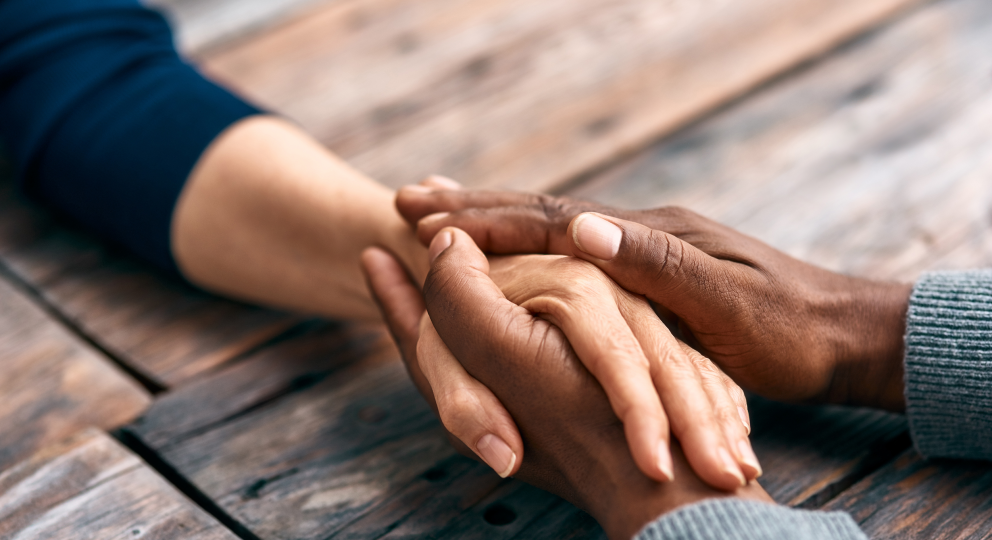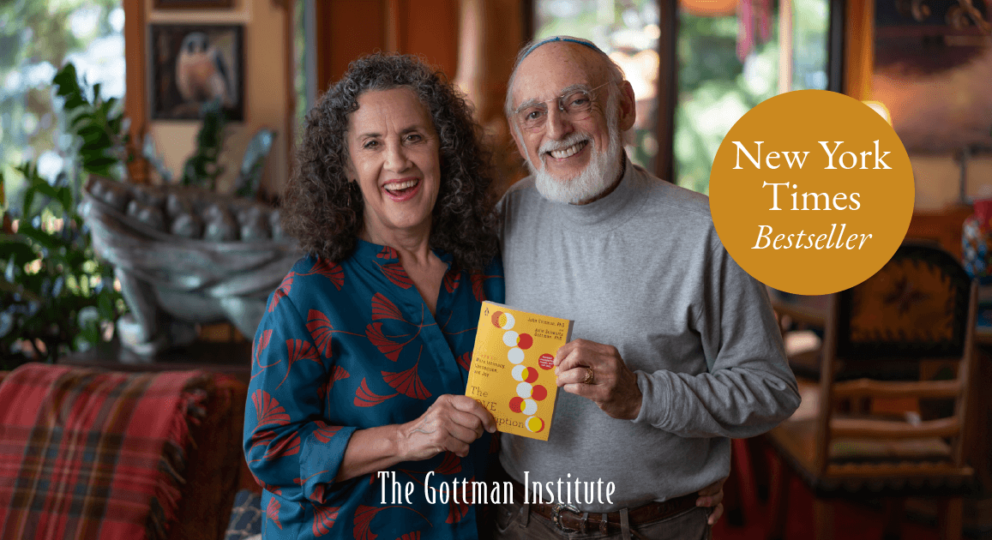 Julie Gottman, Ph.D. is the co-founder and President of The Gottman Institute. A highly respected clinical psychologist, she is sought internationally by media and organizations as an expert advisor on marriage, sexual harassment and rape, trauma, domestic violence, gay and lesbian adoption, same-sex marriage, and parenting issues.
Julie Gottman, Ph.D. is the co-founder and President of The Gottman Institute. A highly respected clinical psychologist, she is sought internationally by media and organizations as an expert advisor on marriage, sexual harassment and rape, trauma, domestic violence, gay and lesbian adoption, same-sex marriage, and parenting issues.
Julie is interviewed by Chris Dollard to discuss how to define and diagnose trauma and the development of the Treating Affairs and Trauma online course from The Gottman Institute. The full interview transcript is below.
You’ve dedicated much of your clinical practice to treating trauma. So, we’re just curious: where does your passion for treating trauma come from, and is there a story behind this?
So, there are several stories. First of all, family story. My mother was a victim of incest, and her mother was also a victim of terrible domestic violence, and that trauma became multi-generational. It got passed down. So, within the family there was always an aura of trauma that wasn’t being talked about and wasn’t being dealt with that manifested through my poor mother’s struggle, distress, and her parenting style, to put it mildly. So that was point one.
Point two is that when I was eighteen, my parents sent me on a trip with a Jewish temple youth group as a gift for graduation to Europe. And part of that was visiting Auschwitz, Dachau, and Mauthausen, three of the worst concentration camps. So when I saw the scratch marks on the wall on the walls of the gas chamber and the shoes of babies and the locks of hair and every other thing you can imagine and don’t want to imagine as exhibits at these camps, let alone walking into the gas chambers myself as part of this group, I understood trauma culturally, ethnically, for my being a member of the people who had suffered genocide.
Not to mention the fact that most of my family were Russian and were killed. They lived during World War II close to the Polish border where Nazis crossed the border and slaughtered most of them and threw them into mass graves. So, trauma was alive and well all around me at every level: the personal and the cultural, as well as the greater family. I’ve always understood trauma on some level that it existed and that I wasn’t a kid who could skate over the fact that trauma exists.
In addition, in my own family, for some unknown reason I became the family therapist, at least for my mother, at about, I don’t know, eight? Nine? Listening to her stories and her tears. So, at ten, I decided I wanted to be a therapist. And all of that was colored by the pain that permeated the air in our home. Then I underwent some trauma myself during college with a couple of rapes and a few other things.
The other thing is that I was very, very, VERY drawn to working with people who were suffering the most. So, in my work, I started working with folks who were schizophrenic and people who were suffering severe trauma and manifesting that trauma through psychoses, through borderline personality characteristics, and tons of PTSD. So I was drawn to working with people like that, and my work began in 1972 with helping to start a counseling center in Colorado Springs during the Vietnam War.
So, we were helping, as best we could, folks who were coming back from Vietnam with, obviously, severe trauma and rejection once they came here, traumatized doubly not only by the war itself, but by how people spat on them as they walked down the street in this country. So, we started a drop-in center for those folks in Colorado Springs, and I was in college at the time. And after that, I went to work in Boston in the “combat zone,” which was the poverty ghetto in Boston, and lots of people were suffering trauma. A lot of Puerto Rican and Black people lived in the ghetto then, and most of those had gone through trauma combined with addiction. I kind of lived and breathed it, worked with heroin addicts and many of whom had gone through trauma, especially the women, and then went to India for a year after working with the mentally ill in a psychiatric hospital in Oregon.
So, three years in Boston, two in Oregon, and I went to India for a year and worked in Calcutta for about six months. Tons and tons and tons of trauma, beyond belief trauma, and this was back in 1978 before the tech industry blossomed and spread to India. So, it’s always been trauma and when I went into grad school, I took a special interest in sexual harassment, rape, and incest, and started treating people and, in particular, during my training the woman who co-authored the first book ever written on father-daughter incest was my supervisor, and I learned a lot about treating folks who had suffered incest, men and women. And I really focused on that heavily during grad school.
And then I came up here and met John, and that was not traumatic, it was glorious!
But I continued to specialize working in trauma and depression and addiction and all of the things that go along with trauma until John and I started to work together with couples and, of course, in couples, you see the same stuff, whether they’re dishing it out to each other or if they’ve come into relationships with it behind them and still with them.
How would you define “trauma,” and are there varying degrees or classifications of trauma?
Trauma is an experience by a person of some event or series of events that are unpredictable and that cause a major threat to that individual’s physical life, emotional life, or spiritual life. A terrible impact in a negative way—that’s what a trauma is.
The DSM-V includes only either a life-threatening event that a person has experienced personally or witnessed happening to someone else. I disagree. It’s not just physical as I write about and talk about in the Treating Affairs and Trauma workshop. An affair threatens the structure by which somebody has created their life, their family values, their values in the loyalty of their partner, the knowledge even of who their partner is as somebody who will practice fidelity and then discovering they don’t.
That turns an individual’s life upside down, and when one is upside down, that’s a good definition of trauma.
I like you putting it that way. Coming off of all of that, how did you develop the Treating Affairs and Trauma course, and what is it based on? Is it derived from any specific theories?
Okay, so, let me divide those into treating trauma and into treating affairs because they are two different topics, although they are related.
Treating trauma developed from the last 25 years of my clinical experience treating couples with trauma and the 20 years before that of only treating individuals with trauma. One of the huge things that is terribly wrong in our field that needs rectifying is that, at this point, there really is only individual treatment for trauma, for the most part. There’s been a tiny bit of research by the EFT folks on treating couples with trauma, but, you know, only with four couples or something, not really what’s needed. And, unfortunately, there isn’t really good research that’s been done on treating couples with trauma.
I didn’t want to wait. I’m getting really old! (laughs.) And I didn’t want to wait to try to create some theory and method and protocol for how to treat couples with trauma because our beloved, blessed couples clinicians are treating couples with trauma every single day, and they’re not quite sure sometimes how to do so and might be making mistakes. And not that I am by any stretch the one person who knows how to do it, there are lots of people, I imagine, who have ideas on how to do it, but I wanted to contribute somehow to helping the clinician who’s facing terrible trauma in their partners sitting in front of them and are not quite sure when one of the partners curls up in a fetal position and the other one is staring at them, dumbfounded.
What do you do, clinician?
So I just wanted to put it all together into something, at least a starting place, for how to integrate couples work and trauma work together so that clinicians would at least have a framework on how to address trauma in their couples, especially given that lots and lots of military folks are coming back from Iraq, Afghanistan, Kuwait, Syria nowadays, everywhere else they’ve been, and trying to reconnect with their partners and, lo and behold, they’ve transformed into different human beings and so have their partners at home, and the two of them walk into an office with clinicians, and especially chaplains helping folks coming out of the military may not be quite sure how to address both couples’ relationship issues and trauma.
So I wanted to put together something that, at least, might be a little helpful for folks, and because my favorite couple in the universe, or at least one of my favorite couples, Paul and Shantel, just happened to call as I was thinking about creating this program and trauma was their issue. They were coming up and trauma had surfaced for them in a very big way, coincidentally, five years after they had done their original therapy with me and they wanted to do another round of therapy to even more directly address trauma that was surfacing for each of them and really coloring the things they had already learned and requiring new growth.
So they came in and got filmed, working on trauma, and it was a perfect unifying of needing good demonstrations of a couple dealing with trauma who would be filmed and my desire to create a program. It all got put together.
In terms of treating affairs, let me just say that what also informed the trauma work was Edna Foa’s work. Lots of people have asked me about EMDR (Eye Movement Desensitization and Reprocessing) and I’ve trained in EMDR, but I haven’t seen the research be convincing about the bilaterlization and eye movement work and so on as something really additional to basic work on trauma that’s been around for a long time.
Edna Foa’s work, on the other hand, has had much, much, much, much better research done on it, much higher standards of research that have shown her work to be extremely helpful. And, so, if there was any theoretical foundation along with our couples work and my own clinical work, Edna Foa’s work was what informed the trauma workshop.
In the couples workshop, John and I suffered a difficult situation involving some betrayal by a third person many years ago, so it wasn’t an affair by any means, it was just somebody who betrayed the two of us. But, that got John to thinking about trust and betrayal, and he went to the library and we had already been familiar with Shirley Glass’s work. But then we discovered Carol Rusbult’s fabulous work and, unfortunately, both of those authors passed away shortly before we began our own theoretical work about affairs and treating affairs. But their work was incredibly helpful and, in looking at our own research combined with Shirley Glass’s clinical work and Carol Rusbult’s research putting together with our own relationship research, we really saw a very clear step-by-step pathway to betrayal.
And John being John, wanting to integrate mathematics into the whole thing, developed some magnificent mathematical formulas and theory that we tested in a lot of our data to see whether or not his formulations really did predict affairs and, sure enough, they did. And then we looked at what should the treatment be, and he and I developed that treatment together because, of course, affairs is a huge issue that everybody deals with when working with couples. And again, the work that was out there was horrible! And to this day there has never been a really good controlled research study on affairs and we are engaged in that right now, here and now, testing our own method in a controlled comparison study.
Again, it was another huge problem in the couples therapy field that we really wanted to address with as much validity and data gathered and testing of theory as we could and that’s what created the Treating Affairs and Trauma program.
You did mention combat veterans coming back from war in Iraq, Afghanistan, Kuwait, etc., so we tend to associate post-traumatic stress disorder with combat veterans, and the general public seems to have gained awareness of the importance of understanding and treating PTSD in recent years. Do other people suffer from PTSD, and what kinds of experiences tend to lead to a diagnosis of PTSD?
PTSD is really interesting, I mean, it can show up in all kinds of situations and not everybody who goes through these situations will suffer from PTSD. However, there are pockets of situations that make it more likely that somebody may suffer from PTSD. So here are some of those little pockets.
One is a major car accident. Two is abuse in the home, be that sexual abuse or physical abuse and sometimes even mental abuse, and it doesn’t have to be abuse that’s experienced directly in the home for the child, it can also be abuse that’s witnessed. So, when a father is beating up a mother and the child witnesses that, that can give rise to PTSD. Rape, of course, sexual harassment can create PTSD. The kinds of clerical sexual abuse that men have experienced as children can create very serious PTSD.
Sometimes, different chronic illnesses can create PTSD. Cancer and the treatment of cancer can create PTSD, so can going through a stroke, going through a heart attack, having major surgery, having your kids go through any of those if you are a parent, that can create PTSD. Severe losses, especially when they’re unpredicted, like the loss of somebody that you love in a circumstance that wasn’t predicted, such as an accident or losing somebody in war can create it as well. Affairs create PTSD. Sometimes financial betrayals can create some PTSD, sometimes sports injuries can create it, I mean, it just depends on the individual. A lot of people experience different types of PTSD or different gradations of it.
Typically what we see is that the worst PTSD occurs in adults who have already suffered trauma in childhood. So, for example, that’s one of the things that has really been found in studies of combat veterans, that PTSD is much more likely in veterans who came out of a traumatic home as kids. Sometimes the stresses of poverty can create a greater propensity for PTSD in adulthood. There’s kid PTSD, some children can suffer from PTSD, especially if they’ve gone through wars as civilians. Lots of our refugees are suffering from PTSD, especially escaping war-torn countries.
And there’s also chronic PTSD, or delayed versus acute PTSD, those are all different types. Chronic PTSD is where there’s a pattern, some kind of interaction or pattern in the home that’s happening repeatedly over and over and over again that can create PTSD. With acute versus delayed PTSD, there may be PTSD right after a traumatic event, but sometimes, I mean, what I saw a lot of in treating Vietnam vets was that the trauma didn’t show up for 20 years and all of a sudden it showed up, something triggered it, and the person was able to compartmentalize whatever they had gone through, but some current event 20 years later blew open the wall separating them from that trauma in combat and up came the trauma along with PTSD. I can think of a number of folks I treated like that. So, you know, it’s kind of a complex picture and there’s a lot more that we still need to understand.
Pivoting off of that, Dr. Richard Tedeschi posits the concept of “post-traumatic growth.” To quote him, he says, “People develop new understandings of themselves, the world they live in, how to relate to other people, the kind of future they might have and a better understanding of how to live life.” Does your work, in particular the Treating Affairs and Trauma course, integrate the concept of post-traumatic growth? And, if it does, how would you yourself explain the concept?
It definitely does. Richard Tedeschi is one of my heroes. He’s a very humble man, and he’s done some deeply profound and meaningful, valuable work treating trauma in adults. And his understanding really dovetails with a piece of what John and I do in our work with PTSD couples, and this is how I would define it.
When one or both partners in a couple has undergone a trauma and is suffering from PTSD, the PTSD blows apart and shatters their former understanding of how to live their life and what may give their lives purpose and meaning. What Dr. Tedeschi recognized is that there is also a beautiful opportunity when treating the trauma to help individuals dig deep inside themselves for, “How do I make sense of this? How do I live my life knowing my child can die in a high school shooting massacre? How do I go on when I can’t pass down my legacy to my child who is now gone? What can I do now to give my life meaning?”
So there’s a beautiful Chinese calligraphy for “crisis,” and it’s a combination of two ideas: one is danger, and the other is opportunity, and those two are also present in a person struggling with PTSD where they have faced danger that in fact has manifested, in some way, they’ve experienced the danger for real. But it also gives people the opportunity to rethink, “What are my days worth now?” And that dovetails with the existential piece of all of the work that John and I have been doing.
So, in our trauma workshop, we absolutely include Tedeschi’s work because you’re not only working with a couple that is dealing with trauma and how to get through it and help and support each other, but also, how are they going to give their lives a much deeper layer of meaning that makes life worth living? Because, in many cases, people are so blown apart by the trauma they’ve gone through that they’re not sure why they should be living. They have to address that question, and they can address it together as a couple in the therapy, and it is one of the most beautiful, wonderful opportunities for the therapist to observe profound human strength and resilience and the beauty of what humans can spin out of tragedy. It makes the work worth doing.
That’s a beautiful take on how to proceed afterward, and this actually leads into our next question. You’ve figuratively described trauma in a relationship as “a big bucket of ice water.” So, I’m wondering if you could unpack that metaphor a little bit and explain it as to how couples can work together to identify, process, and overcome trauma?
So, what I imagined with the metaphor of a bucket of ice water is that when an individual has been traumatized, they’re being asked, alone, to carry this big, heavy bucket of ice water, which is kind of off balance and it’s very difficult for that individual to carry it alone, and every now and again the ice water splashes around, splashes all over them, and leads them to freeze, to be cold, to be wet, to feel horrible and to shiver with the discomfort and distress.
That’s the triggering of a trauma that is part of what somebody experiences in PTSD. And I imagined also that when a couple is dealing with a trauma together, then each one has a hand on the handle of the bucket, with the bucket between them of ice water, and if any of you have tried to carry a bucket of water, it’s much easier to do with two people on either side of that bucket than doing alone off-balance. So, what I imagined is that, together, they can carry that bucket of ice water and, through supporting each other, bringing each individual’s strength together to deal with the trauma, rather than leaving it all up to one individual.
That ice water wouldn’t spill nearly as often. It’s not going to cease to exist. It’s not going to be emptied out, leaving everybody just hunky-dory and happy, but it won’t spill nearly as often if they’re both carrying it together. That was the metaphor.
Excellent. And I’m just curious, going off of that metaphor, would there at any point be any emptying of the ice water, or any reduction, or is it really just something that they carry together, you know, going forward?
Well, I’d like to think that there is some emptying of it along the way through the process of time. However, I’m not one of those people that believes you can ever completely vanquish trauma. Trauma leaves scars, and scar tissue is brittle, it’s not like normal, elastic, healthy tissue, so that when it’s poked, as life is wont to do, kind of pushing buttons here and there of that scar tissue, a little bit of PTSD may resurface now and then. So, yeah, the bucket can be partially emptied maybe over time and through strength and growth, but never, probably, fully emptied.
That makes sense. Would you maybe describe that as a process of integrating it into an individual’s or a couple’s lives together so that way it’s understood and carried together, rather than overcoming it or dealing with it or vanquishing it, would it be more of an integration process?
It depends on what you mean by integration. Some people can interpret integration to mean that it kind of melts into everything else in your life. And trauma usually isn’t like that, just the way that scar tissue isn’t the same as healthy tissue. You’re always going to have that scar tissue.
So, it’s more like an enduring vulnerability. But, with that said, integration could be considered if you think about integration as, okay, here we are again. You’re diving under the table again, as a combat vet, because you’re hearing a helicopter overhead and you think it’s going to fire down on our house and blow us up. So, here we are again, okay, we know what to do with this. Let me come under the table with you so that you’re not alone. There’s integration—the tenth time it happens.
And this will be our last question. If you could, what advice would you offer to any individuals or couples who either have experienced any trauma or are suffering from trauma today?
Two different questions. So what would I suggest to individuals, and what would I suggest for couples? Well, for either person, a couple of books might help. One is Victor Frankl’s book The Will to Meaning, which is written a little bit for a clinician since it has a little bit of theory in it, but it really is talking about how do we go on with our lives when we’ve suffered terrible trauma. And the other is reading what Richard Tedeschi has written about post-traumatic growth and, if needed, going to a therapist, particularly somebody who is well-versed in Edna Foa’s work in treating PTSD.
If you’re part of a couple and you’ve gone through trauma individually, I would really highly recommend, not to be self-serving, but going to a couples therapist, hopefully a couples therapist who understands how to treat trauma in a couples therapy because I believe that how trauma affects the relationship is an incredibly important factor that has to be addressed when a person has been traumatized and they’re in a relationship, because it affects the partner of the person who’s been traumatized in different ways, but extensively. And that person and the relationship itself all need support. So, I would highly encourage folks where one person has been traumatized to seek couples therapy to deal with it.
If you are a professional who works with couples or with individuals suffering from trauma and PTSD, we encourage you to sign up for our new online course, Treating Affairs and Trauma. This training includes videos of Drs. John and Julie Gottman working with real couples in their private practice, as well as engaging lectures and discussions about Gottman Method Couples Therapy.
If you are suffering from trauma or need assistance in your own relationship, you can find a Gottman-trained therapist in your area by using the Gottman Referral Network.
If you want to build a deeply meaningful relationship full of trust and intimacy, then subscribe below to receive our blog posts directly to your inbox:







